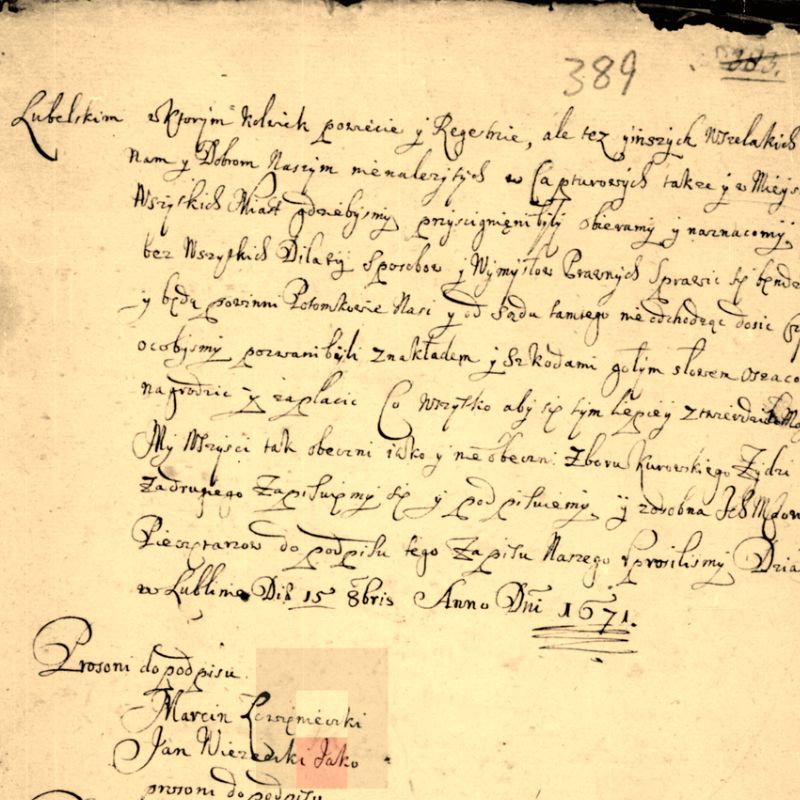The Documentation Trail in Kurów (Lublin Region)
This article was authored by Robert Pullman.
The town of Kurów was one of the most important cultural and economic centers in the province of Lesser Poland around 1825 after Lublin and Pulawy. JRI-Poland volunteers have scoured nearly 500 years of records to paint the following picture of the documentation trail in Kurów outlining its Jewish history.
The Kurowka River connects Kurów with the city of Lublin 40 km southeast and the town of Pulawy, 15 km northwest. At that time, there was already a rail connection, actually in the village of Klementowice, on the outskirts of Kurów. Transportation between Kurów and larger towns had become easy which sparked its growth.
For Jews, Kurów had already been an important location for 150 years when the decree of 1671 granted them civil rights, nearly on par with the long-established Catholic majority. Ten years before that, marauding Cossacks had destroyed the entire town and murdered most of its population. In the 17th century, as Kurów was rebuilding, Jews were vital to its economy and began appearing in the town’s written record.
Early Notary Records
There are several hundred notary records of Jewish business and legal affairs which remarkably survive in the Kurów City Records (“Akta Miasta”) from 1667-1810. Most of these document business transactions but some are decrees establishing property rights or settling disputes between individuals. Some notable examples include:
- In 1672, a minyan convened with local authorities to ratify the 1671 decree granting Jews the right to create a market and to build a synagogue, school, baths, and hospital. These men were Zelman Szaiewic, Moszko Jakubowic, Szmul Nachmanowic, Ber Dawidowic, Mendel Lewkowic, Aaron Lewkowic, Laser Jerkowic, Kelman Abramowic, Jeul Jozwowic, and Dawid Ickowic.
- In 1718, Izaak Pinkwasowicz, otherwise unknown, was installed as Rabbi of Kurów.
- In 1798, Rabbis Izrael Lewi Horowicz of Lublin, Leyb of Pinczow, and Herszel of Wlodzimierz attended to the disposition of a bench belonging to Kurów’s school. A six-page document details this case. Also involved was Zelman Judkowicz Lewi Horowicz of uncertain relationship to Rabbi Izrael.
- In 1807, Szmul Izraelowicz was taken to task for abrogating the terms of the will of his father Rabbi Izrael Jakierowicz who had died in 1799. A six-page document cites specific issues and mandates their remediation.

Pre-1826 Jewish Vital Records
Kurów’s civil records begin in 1810 and are complete for 1810-1825 for births, marriages and deaths. JRI-Poland volunteers have extracted the details of this early record group: they are available through searches on the JRI-Poland Legacy Database. These register books combine records for Catholics, Jews and other non-Catholics. Curiously, Jews are absent from these registers from April 1813 until August 1815, but there are seemingly complete books of records for Catholics during this time.
There were two famines during this pre-1826 period: 1816 and 1822. The famine of 1816 was a worldwide phenomenon – the so-called “Year Without Summer.” By contrast, the famine of 1822 was localized to parts of Europe.
The effect of these famines is clear from the number of deaths recorded during those and the following years. Many of the deceased, some formerly prominent members of the community, are described in their death records as paupers.
Jewish Vital Records 1826-1939
As was the norm throughout Congress Poland, starting in 1826, the Jewish civil records were kept separately from the Catholic and other records. Unfortunately, there is a large gap in the Kurów Jewish vital records between 1826 and 1866. There are no surviving registers for most of those 40 years; the surviving records were badly damaged by fire or water. For the past 20 years, JRI-Poland was unable to get access to the post-1847 Jewish records for Kurów. We now know that it was the heavy damage that prevented the Lublin Archive from making them available. Volunteers and professionals are now working to extract whatever nuggets we can from the surviving fragments now that we finally have public access to them. The 1855 and 1866 registers were particularly damaged by time.
The later Jewish records (1867-1939) have survived intact. The registers between 1868-1915 were written in Russian Cyrillic – reflecting that Poland was part of the Russian Empire during this period. There are many family names which are common in these later records and that also appear in the earlier 1810-1825 records, as well as in the surviving records from the intervening years. Other surnames only appear in the 20th century, or the late 19th century, indicating a movement of new families into Kurów.
In rare cases, providing opportunities for interesting analysis and conclusions, family names appearing in the 20th century records can be traced back to the notary records from the late 18th century. As the Jewish population of Kurów never exceeded 2000-2500 since the late 18th century, one may find it unusual if not remarkable that an early Jewish extended family maintained residence in Kurow for well over a century.
Visit the Akta Miasta Kurów (City Files Kurów)
Links to scans available here
Commemorating Nearly 500 Years
Kurów has a sad history. It was leveled by the Cossacks and its Jewish population massacred in the 1600s. Then, 300 years later, it was almost completely destroyed in WWII with just a few of the pre-war structures surviving the bombings. While there are very few records from before 1667 in the City Records, those that survive indicate a Jewish presence in Kurów from the 1400’s. Thus, the JRI-Poland document trail commemorates a Jewish community that existed for more than 500 years in the town of Kurów.
Like Kurów, each community has a story…some thoroughly documented in one way or another. While there are others for which there is minimal information, we encourage our research community to dig deep into their towns’ stories and, where possible, enhance your family history with relevant social details of times past.